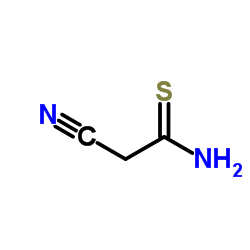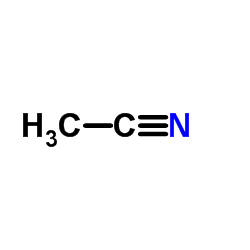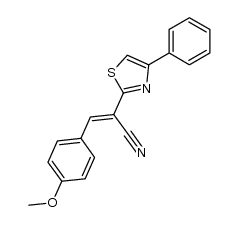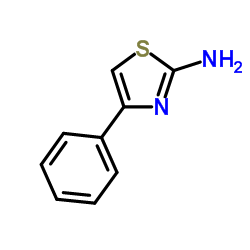2-(4-Phenylthiazol-2-Yl)Acetonitrile

2-(4-Phenylthiazol-2-Yl)Acetonitrile structure
|
Common Name | 2-(4-Phenylthiazol-2-Yl)Acetonitrile | ||
|---|---|---|---|---|
| CAS Number | 41381-89-9 | Molecular Weight | 200.26000 | |
| Density | 1.223g/cm3 | Boiling Point | 378.5ºC at 760mmHg | |
| Molecular Formula | C11H8N2S | Melting Point | 59ºC | |
| MSDS | N/A | Flash Point | 182.7ºC | |
| Name | 2-(4-phenyl-1,3-thiazol-2-yl)acetonitrile |
|---|---|
| Synonym | More Synonyms |
| Density | 1.223g/cm3 |
|---|---|
| Boiling Point | 378.5ºC at 760mmHg |
| Melting Point | 59ºC |
| Molecular Formula | C11H8N2S |
| Molecular Weight | 200.26000 |
| Flash Point | 182.7ºC |
| Exact Mass | 200.04100 |
| PSA | 64.92000 |
| LogP | 2.87618 |
| Index of Refraction | 1.61 |
| InChIKey | SOFCSIBVJROWGI-UHFFFAOYSA-N |
| SMILES | N#CCc1nc(-c2ccccc2)cs1 |
Synonym: Section 2 - COMPOSITION, INFORMATION ON INGREDIENTS
Risk Phrases: 20/21/22 Section 3 - HAZARDS IDENTIFICATION EMERGENCY OVERVIEW
Harmful by inhalation, in contact with skin and if swallowed. Potential Health Effects Eye: May cause eye irritation. Skin: May cause skin irritation. Harmful if absorbed through the skin. Ingestion: Harmful if swallowed. May cause irritation of the digestive tract. Inhalation: Harmful if inhaled. May cause respiratory tract irritation. Chronic: Not available. Section 4 - FIRST AID MEASURES Eyes: Flush eyes with plenty of water for at least 15 minutes, occasionally lifting the upper and lower eyelids. Get medical aid. Skin: Get medical aid. Flush skin with plenty of water for at least 15 minutes while removing contaminated clothing and shoes. Ingestion: Get medical aid. Wash mouth out with water. Inhalation: Remove from exposure and move to fresh air immediately. If not breathing, give artificial respiration. If breathing is difficult, give oxygen. Get medical aid. Notes to Physician: Section 5 - FIRE FIGHTING MEASURES General Information: As in any fire, wear a self-contained breathing apparatus in pressure-demand, MSHA/NIOSH (approved or equivalent), and full protective gear. Extinguishing Media: Use water spray, dry chemical, carbon dioxide, or chemical foam. Section 6 - ACCIDENTAL RELEASE MEASURES General Information: Use proper personal protective equipment as indicated in Section 8. Spills/Leaks: Vacuum or sweep up material and place into a suitable disposal container. Section 7 - HANDLING and STORAGE Handling: Avoid breathing dust, vapor, mist, or gas. Avoid contact with skin and eyes. Storage: Store in a cool, dry place. Store in a tightly closed container. Section 8 - EXPOSURE CONTROLS, PERSONAL PROTECTION Engineering Controls: Use adequate ventilation to keep airborne concentrations low. Exposure Limits CAS# 41381-89-9: Personal Protective Equipment Eyes: Not available. Skin: Wear appropriate protective gloves to prevent skin exposure. Clothing: Wear appropriate protective clothing to prevent skin exposure. Respirators: Follow the OSHA respirator regulations found in 29 CFR 1910.134 or European Standard EN 149. Use a NIOSH/MSHA or European Standard EN 149 approved respirator if exposure limits are exceeded or if irritation or other symptoms are experienced. Section 9 - PHYSICAL AND CHEMICAL PROPERTIES Physical State: Solid Color: Not available. Odor: Not available. pH: Not available. Vapor Pressure: Not available. Viscosity: Not available. Boiling Point: Not available. Freezing/Melting Point: 58 - 60 deg C Autoignition Temperature: Not available. Flash Point: Not available. Explosion Limits, lower: Not available. Explosion Limits, upper: Not available. Decomposition Temperature: Solubility in water: Specific Gravity/Density: Molecular Formula: C11H8N2S Molecular Weight: 200 Section 10 - STABILITY AND REACTIVITY Chemical Stability: Not available. Conditions to Avoid: Incompatible materials. Incompatibilities with Other Materials: Oxidizing agents. Hazardous Decomposition Products: Hydrogen cyanide, nitrogen oxides, carbon monoxide, oxides of sulfur, carbon dioxide, acrid smoke and fumes. Hazardous Polymerization: Has not been reported Section 11 - TOXICOLOGICAL INFORMATION RTECS#: CAS# 41381-89-9 unlisted. LD50/LC50: Not available. Carcinogenicity: 2-(4-Phenyl-1,3-thiazol-2-yl)acetonitrile - Not listed by ACGIH, IARC, or NTP. Section 12 - ECOLOGICAL INFORMATION Section 13 - DISPOSAL CONSIDERATIONS Dispose of in a manner consistent with federal, state, and local regulations. Section 14 - TRANSPORT INFORMATION IATA Shipping Name: NITRILES, SOLID, TOXIC, N.O.S.* Hazard Class: 6.1 UN Number: 3276 Packing Group: III IMO Shipping Name: NITRILES, TOXIC, N.O.S. Hazard Class: 6.1 UN Number: 3276 Packing Group: III RID/ADR Shipping Name: NITRILES, TOXIC, N.O.S. Hazard Class: 6.1 UN Number: 3276 Packing group: III Section 15 - REGULATORY INFORMATION European/International Regulations European Labeling in Accordance with EC Directives Hazard Symbols: XN Risk Phrases: R 20/21/22 Harmful by inhalation, in contact with skin and if swallowed. Safety Phrases: S 36/37 Wear suitable protective clothing and gloves. WGK (Water Danger/Protection) CAS# 41381-89-9: No information available. Canada None of the chemicals in this product are listed on the DSL/NDSL list. CAS# 41381-89-9 is not listed on Canada's Ingredient Disclosure List. US FEDERAL TSCA CAS# 41381-89-9 is not listed on the TSCA inventory. It is for research and development use only. SECTION 16 - ADDITIONAL INFORMATION N/A |
| Hazard Codes | Xi: Irritant; |
|---|---|
| Risk Phrases | R20/21/22 |
| Safety Phrases | 26-36/37/39 |
| RIDADR | UN 3276 |
| HS Code | 2934100090 |
|
~86% 
2-(4-Phenylthia... CAS#:41381-89-9 |
| Literature: NOVUSPHARMA S.P.A. Patent: WO2003/105842 A1, 2003 ; Location in patent: Page 65 - 66 ; |
|
~71% 
2-(4-Phenylthia... CAS#:41381-89-9 |
| Literature: Shionogi and Co., Ltd. Patent: EP2351744 A1, 2011 ; Location in patent: Page/Page column 59-60 ; |
|
~% 
2-(4-Phenylthia... CAS#:41381-89-9 |
| Literature: Hussain, Sohair Mohamed; El-Reedy, Ahmed Mohamed; El-Sharabasy, Salwa Ahmed Tetrahedron, 1988 , vol. 44, # 1 p. 241 - 246 |
|
~% 
2-(4-Phenylthia... CAS#:41381-89-9 |
| Literature: Hussain, Sohair Mohamed; El-Reedy, Ahmed Mohamed; El-Sharabasy, Salwa Ahmed Tetrahedron, 1988 , vol. 44, # 1 p. 241 - 246 |
|
~% 
2-(4-Phenylthia... CAS#:41381-89-9 |
| Literature: Shionogi and Co., Ltd. Patent: EP2351744 A1, 2011 ; |
| HS Code | 2934100090 |
|---|---|
| Summary | 2934100090 other compounds containing an unfused thiazole ring (whether or not hydrogenated) in the structure VAT:17.0% Tax rebate rate:9.0% Supervision conditions:none MFN tariff:6.5% General tariff:20.0% |
| 4-phenylthiazol-2-acetonitrile |
| (4-phenyl-1,3-thiazol-2-yl)-acetonitrile |
| 2-(4-phenyl-1,3-thiazol-2-yl)ethanenitrile |
| 4-phenylthiazol-2-yl-acetonitrile |
| 2-cyanomethyl-4-phenyl-thiazole |
| 2-(4-Phenylthiazol-2-yl)acetonitrile |
| MFCD00551791 |
| 2-thiazoleacetonitrile,4-phenyl |





